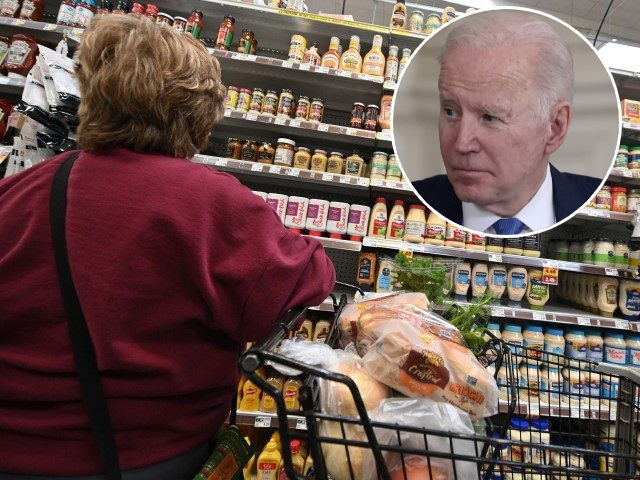U.S. consumers faced higher prices for food in July, undermining Biden White House claims that inflation ran at zero in the month.
The Bureau of Labor Statistics Producer Price Index showed on Thursday that consumer food prices charged by U.S. producers rose two percent in July compared with the previous month. Compared with a year ago, consumer food prices are up 15.8 percent, the highest year-to-year rate of inflation since 1974.

That’s an even higher level of food inflation than was reported in the Consumer Price Index released on Wednesday. It showed prices for groceries rising 1.3 percent compared with the prior month and up 13.1 percent compared with a year ago, the most since 1979.
The Producer Price Index measures prices received by U.S. businesses, so it excludes imported goods and does not include sales taxes, both of which are included in the Consumer Price Index. The producer price barometer also includes export prices, which are excluded from the consumer price gauge.
This month the price index for exported food declined 3.6 percent and is up 12.3 percent, indicating the gains in the consumer foods index represented U.S. consumers paying more for foods they purchase.
Some of the biggest price moves.
- Fresh fruits and melons: up two percent from a month earlier and 21.2 percent from a year ago.
- Fresh and dry vegetables: up 12.7 percent from a month earlier and 65.5 percent from a year ago.
- Fresh eggs: up 44.2 percent in July and 171.5 percent from a year ago.
- Bakery products: up 1.7 percent in July and 12.7 percent from a year ago.
- Pasta products: up 5.9 percent in July and 32.6 percent from a year ago.
Not all food prices were up as measured by the PPI. The prices of most meats—including chicken, pork, and beef—fell in the month. The overall index for meat is down 2.3 percent on a decline of pork and beef prices. This reflects the huge increase seen in meat prices early in this inflation cycle. Last July, for example, the index for meat was up 33 percent year over year.
The meat price index is up 23.1 percent since its summer 2019 levels, the last comparable month before the pandemic. That averages to around 7.7 percent annual inflation since then. Prior to the pandemic, the average annual gain in the producer price index for meat was just one percent.

Although chicken prices fell 2.2 percent in July, they are still up 18.3 percent from a year ago.
The broadest measure of prices in the Producer Price Index fell by half a percentage point in July thanks to declining gasoline prices. Compared with a year ago, however, prices are still up 9.8 percent.

COMMENTS
Please let us know if you're having issues with commenting.